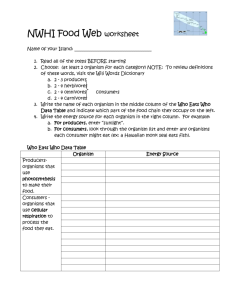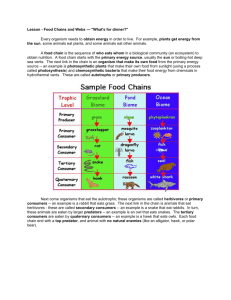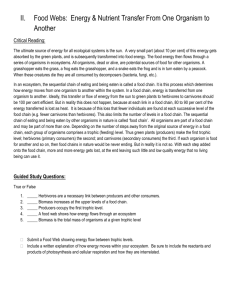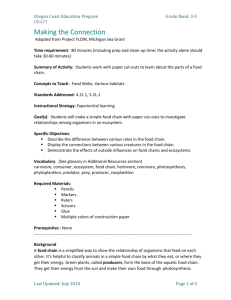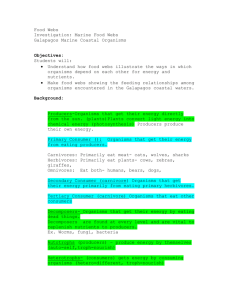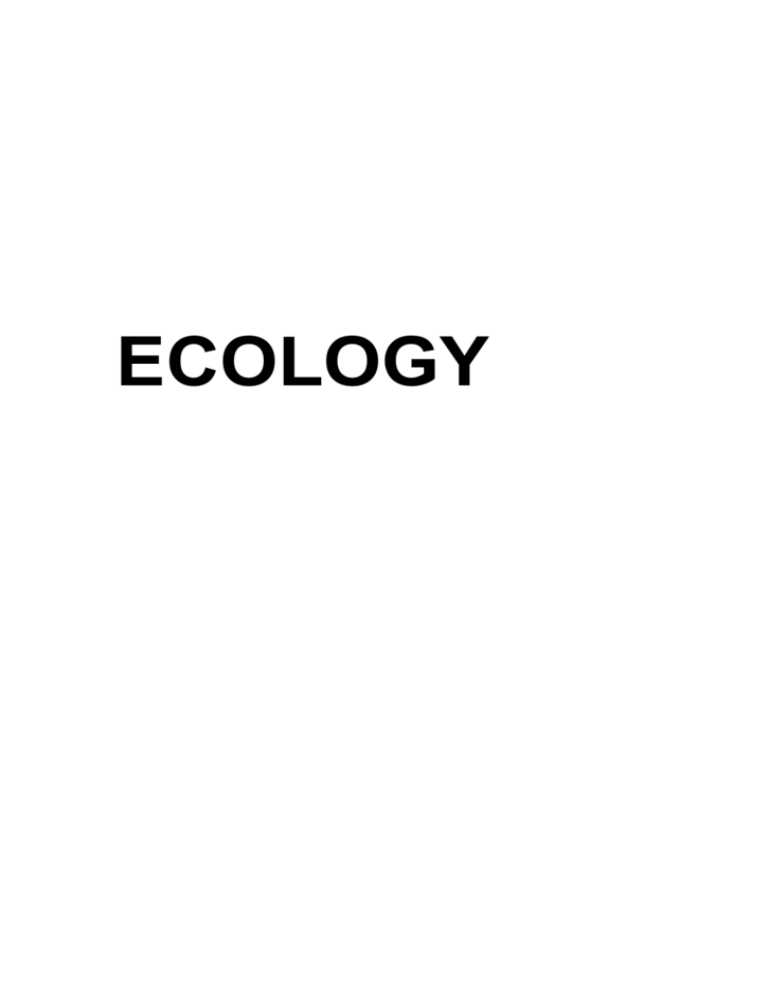
ECOLOGY
Table of Contents:
1. Lesson 1- What is Ecology?
1
2. Lesson 2- Energy Flow Through an Ecosystem
7
3. Lesson 3- Food Chains and Webs
12
4. Worksheet- Food Chain
15
5. Worksheet- Food Web
16
6. Worksheet- Food Chain QUIZ 1 & 2
17
7. Worksheet- Match the food chain
19
8. Worksheet- Trophic Levels
20
9. Worksheet- Food Webs Definition
22
10. Worksheet- Vocabulary Skills
24
11. Worksheet- Principles of Ecology (Organisms and Their Environment)
26
12. Worksheet- Principles of Ecology (Nutrition and Energy Flow)
28
13. Worksheet- Ecology: Reinforcement
30
14. Worksheet- Ecology of Organisms
31
15. Lab Exercise 1 – From Land to Mouth
33
16. Assignment 1 – Create a Concept Map
35
17. Assignment 2 – Build a Food Web or Biome Children’s Book
37
18. Assignment 3 – Human Impact on Food Chains and Webs
40
19. Glossary
42
20. Appendix – A
45
Lesson - Food Chains and Webs --- "What's for dinner?"
Every organism needs to obtain energy in order to live. For example, plants get
energy from the sun, some animals eat plants, and some animals eat other animals.
A food chain is the sequence of who eats whom in a biological community (an
ecosystem) to obtain nutrition. A food chain starts with the primary energy source, usually
the sun or boiling-hot deep sea vents. The next link in the chain is an organism that make
its own food from the primary energy source -- an example is photosynthetic plants that
make their own food from sunlight (using a process called photosynthesis) and
chemosynthetic bacteria that make their food energy from chemicals in hydrothermal vents.
These are called autotrophs or primary producers.
Next come organisms that eat the autotrophs; these organisms are called herbivores
or primary consumers -- an example is a rabbit that eats grass. The next link in the chain is
animals that eat herbivores - these are called secondary consumers -- an example is a
snake that eat rabbits. In turn, these animals are eaten by larger predators -- an example is
an owl that eats snakes. The tertiary consumers are eaten by quaternary consumers -- an
example is a hawk that eats owls. Each food chain end with a top predator, and animal with
no natural enemies (like an alligator, hawk, or polar bear).
The arrows in a food chain show the flow of
energy, from the sun or hydrothermal vent
to a top predator. As the energy flows from
organism to organism, energy is lost at each
step. A network of many food chains is
called a food web.
Trophic Levels:
The trophic level of an organism is the position it holds in a food chain.
1. Primary producers (organisms that make their own food from sunlight and/or
chemical energy from deep sea vents) are the base of every food chain - these
organisms are called autotrophs.
2. Primary consumers are animals that eat primary producers; they are also called
herbivores (plant-eaters).
3. Secondary consumers eat primary consumers. They are carnivores (meat-eaters)
and omnivores (animals that eat both animals and plants).
4. Tertiary consumers eat secondary consumers.
5. Quaternary consumers eat tertiary consumers.
6. Food chains "end" with top predators, animals that have little or no natural enemies.
When any organism dies, it is eventually eaten by detrivores (like vultures, worms
and crabs) and broken down by decomposers (mostly bacteria and fungi), and the exchange
of energy continues.
Some organisms' position in the food chain can vary as their diet differs. For
example, when a bear eats berries, the bear is functioning as a primary consumer. When a
bear eats a plant-eating rodent, the bear is functioning as a secondary consumer. When
the bear eats salmon, the bear is functioning as a tertiary consumer (this is because salmon
is a secondary consumer, since salmon eat herring that eat zooplankton that eat
phytoplankton, that make their own energy from sunlight). Think about how people's place
in the food chain varies - often within a single meal!
Numbers of Organisms:
In any food web, energy is lost each time one organism eats another. Because
of this, there have to be many more plants than there are plant-eaters. There are more
autotrophs than heterotrophs, and more plant-eaters than meat-eaters. Each level has
about 10% less energy available to it because some of the energy is lost as heat at each
level. Although there is intense competition between animals, there is also
interdependence. When one species goes extinct, it can affect an entire chain of other
species and have unpredictable consequences.
Equilibrium
As the number of carnivores in a community increases, they eat more and more of
the herbivores, decreasing the herbivore population. It then becomes harder and harder for
the carnivores to find herbivores to eat, and the population of carnivores decreases. In this
way, the carnivores and herbivores stay in a relatively stable equilibrium, each limiting the
other's population. A similar equilibrium exists between plants and plant-eaters.
Complete the Food Chains Worksheet
Circle the organisms that complete the food chains below.
Food Web Worksheet
Read the passage then answer the questions below.
The arrows in the food chain
represent the flow of energy
Sun
Autotroph
primary producers
primary consumers
herbivores
top predator
producers
heterotrophs
autotrophs
producers
a producers
primary consumers
secondary consumers
Food Chain Quiz - Multiple choice comprehension questions
Color the circle by each correct answer.
Food Chain Quiz #2 - Multiple choice comprehension questions
Color the circle by each correct answer.
Match each Food Chain Word to its Definition.
Food Chain Trophic Levels - Worksheet
hawk
snake
fish
dragon flies
lions
Rats
Grasshoppers
mosquitos
Worksheet – Introduction to Food Webs
Food Web Worksheet
Identify the:
1. Producers
2. Primary Consumers
3. Secondary Consumers
4. Herbivores
5. Carnivores
6. Omnivores
7. What elements
are missing from
this food web?
The elements
that are missing
are the tertiary
and quaternary
consumers.
On the back, construct a Food web using the following animals. This ecosystem represents
a farm area. The corn is the main source of food for many of the herbivores in the area. You
do not have to draw pictures; you can just use the animal names and draw arrows between
them.
SNAKE, CORN, CATERPILLAR, DEER, CROW, MOUSE, COUGAR, SQUIRREL,
MICROORGANISMS (decomposers)
Worksheet – Food Webs
1. Define and provide examples for each of the following groups of heterotrophs.
a) Herbivores –
an organism that eats plants
Zebra
b) Carnivores –
an organism that eats meat
Snakes
c) Omnivores –
organisms that eat both plants and meat
Humans
d) Saprophytes –
organisms that eat dead organisms
vulture
e) Decomposers –
organisms that break down dead organisms
Bacteria
2. Using the organisms named below create a food web which represents the flow of energy
between organisms by using arrows to connect the organisms.
(Note: You should have more then one arrow pointing towards and pointing away from any
given organism.)
Lab Exercise 1 - From Land to Mouth
A field of corn contains a certain amount of food energy. If cattle eat the corn, they will gain
some of the food energy. How does the amount of energy in the corn compare with the
amount of energy in the cattle? Is it more efficient to feed on corn or beef? In this activity,
you will compare the energy content of some familiar human foods.
You will need: graph paper, calculator, and colored pencils/markers
What to do:
1. The table below lists the average amount of energy (in kilojoules per square meter of
land per year) in different organisms that people use for food.
Organism
Wheat cereal
Oranges and grapefruits
Peanuts
Rice
Potatoes
Carrots
2
Energy (KJ/m /year)
3 400
4 200
3 850
5 200
6 700
3 400
Ranking
9
12
11
13
16
8
Other vegetables
Apples
Peaches
Beet sugar
Cane sugar
Corn
Milk (cow)
Eggs (chicken)
Chicken
Pork (pig)
Beef (cow)
Fish
840
6 300
3 800
8 300
14 650
6 700
1 800
840
800
800
550
8
6
15
10
17
18
14
7
5
4
3
2
1
a. Organize the data from LEAST energy to MOST energy. (Do this under the
“Ranking” column in the table above)
b. Make a bar graph to compare the relative amounts energy in each organism:
i. Include a LEGEND:
Use one color for producers and another color for consumers
ii. Label bottom with the names of each organism
iii. Label the left side with the energy
From Land to Mouth
YOU WILL BE USING GRAPH PAPERS THAT WILL NEED TO BE HANDED IN TO ME
FOR ASSESSMENT.
2. Calculate the AVERAGE energy of all the producers.
Average: 5318.461538
3. Calculate the AVERAGE energy of all the consumers.
Average : 799.6666667
4. Which organisms (producers or consumers) can offer more energy (on average)?
The producers can offer more energy
Do you think it is more efficient for people to eat plant products or animal products? Why
It is more efficient for people to eat animal products . animals have already
consumed energy from plants or other animals so it gives human the highest
amount of energy possible.
This material is based on work supported by the National Science Foundation under Grant No.
1054754. Any opinions, findings, and conclusions or recommendations expressed in this
material are those of the author(s) and do not necessarily reflect the views of the National
Science Foundation.
Copyright © 2012 by the Center for Pre-College Programs, ofthe New Jersey Institute of
Technology.All Rights Reserved.
Supporting Program: Center for Pre-College Programs, at the New Jersey Institute of
Technology
Contributors
Kunjamma Paulose ( Science Park High School, Newark, NJ), Primary Author
Howard Kimmel, Levelle Burr-Alexander, John Carpinelli - Center for pre-College Programs,
NJIT.


